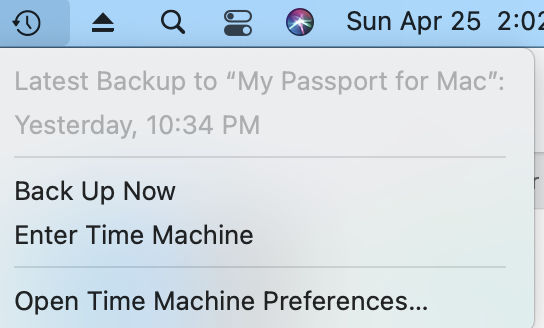

- #Using mac time machine clone hardrive how to#
- #Using mac time machine clone hardrive portable#
- #Using mac time machine clone hardrive windows#
#Using mac time machine clone hardrive windows#
FAT32 was introduced in Windows 95 in 1997, but it remains useful because nearly every system can work with it. FAT32 (File Allocation Table 32) is an older file system that both Windows machines and Macs still support.exFAT works on both macOS and Windows, and it doesn’t have the 4 GB file-size limit that FAT32 does, so you’ll be able to back up movies and other large files. If you need to transfer files between Mac and Windows computers, exFAT (extended File Allocation Table) is the best option, although it doesn’t work with File History or Time Machine.If you’re using an SSD, there is a newer format called APFS (Apple File System), which is intended for built-in drives and external SSDs for newer Macs.(Check the product listing to confirm the drive will be labeled as an HDD or SSD.) If you plan to use an external hard drive (HDD), which costs less than an external solid-state drive (SSD) for more storage capacity but has the downside of slower transfer times and a far less durable design, you should use HFS+ (Hierarchical File System Plus, also called macOS Extended Journaled). Typically, if an external drive is physically larger than a deck or cards or has more than 2 TB of storage, it’s an HDD.macOS and Linux computers, however, can only read files stored on such a drive they cannot write to an NTFS-formatted drive. NTFS is native to Windows, and most hard drives are preformatted for this file system.


If you plan to use your drive for File History backups on a Windows computer, and you use only Windows, stick to NTFS (New Technology File System).So how do those five file systems differ, and which one is right for you? Non-Linux computers can use five main file systems: NTFS, HFS+, APFS, exFAT, and FAT32. If you use a Mac, the likelihood that you’ll have to reformat the drive is higher. But if you buy a drive secondhand or if you plan to switch between operating systems, you may still need to reformat it for use on Windows.
#Using mac time machine clone hardrive portable#
Nor does Apple have any reason to back-port that role type.If you buy an external drive-such as one of our recommended portable or desktop hard drives, portable solid-state drives, or USB 3.0 flash drives-you may need to reformat it to work with your operating system of choice, since different operating systems use different file systems to process data.Īlthough it’s true that any drive is compatible with both Windows and macOS once it’s formatted properly, most drives come preformatted for Windows out of the box.
#Using mac time machine clone hardrive how to#
In Big Sur, Apple added the Backup role, designed for Time Machine snapshots and incremental backups, and which is effectively unreadable in Catalina and earlier, because those releases simply don’t know how to interpret it. (In Catalina, Apple added volume groups, which are used to hold the operating system itself in pieces, separating your data from system files, enhancing system security and integrity.) You can have several volumes in a container that dynamically share the space allotted to the container, which means you don’t have to allocate storage space to a given volume beforehand.

Each container has one or more volumes, and each volume (starting in High Sierra) has a “role,” which defines the kind of volume it is. APFS divides a disk into one or more containers (similar to partitions). Not only must you use Big Sur to back up to an APFS-formatted Time Machine volume, you can’t even access the backups from a Mac with Catalina or an earlier macOS version installed. This might go without saying, but I know enough people with mixed-system setups who will ask. I would set up any new Time Machine volume formatted with APFS, but not convert an old one from HFS+.īig Sur APFS-based Time Machine backups can’t be used in Catalina or earlier releases. While APFS has advantages for SSD-based storage, there really aren’t any for hard disk drives, the most likely kind of drive used for large-capacity backup drives.


 0 kommentar(er)
0 kommentar(er)
